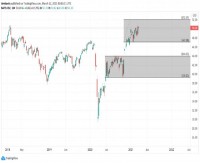|
Opalesque Industry Update – PerTrac Financial Solutions (PerTrac) announced today the results of its 2009 PerTrac Hedge Fund Database Study based on a comprehensive survey of ten of the world’s leading databases. While the study revealed that the number of hedge funds and funds of funds reporting to the databases fell last year by approximately 8.6%, it also showed an increase in total industry assets of 5.5%. “Our study paints a picture of a hedge fund industry still struggling to regain its footing after the market meltdown of 2008,” said Meredith Jones, managing director of PerTrac. “Hedge fund assets reported to the databases rose by 5.5% over the year, to $1.41 trillion, still well short of their high-water mark at the end of 2007 when they topped $2 trillion. However, the assets flowing through funds of funds into the industry dropped sharply, by 22.7%, from year-end 2008 to year-end 2009. In contrast to the modest asset increase, the number of funds actively reporting to databases declined by only 8.6%, with the number of actively reporting single managers dropping by 9.4% and the number of reporting funds of funds falling by 7.1%. It is important to note, however, that non-reporting funds did not necessarily close their doors. Funds stop reporting to databases for a variety of reasons, among them poor performance, strong performance, personnel changes, hard closes, soft closes and business failure. “Overall, we are encouraged by the results,” Ms. Jones added. “2009 was certainly a mixed bag for the hedge fund industry. Performance was generally strong, assets held relatively steady, and while the number of hedge fund and fund of hedge funds causalities was historically high, the survival rate was perhaps higher than most would have predicted.” The study, released annually since 2003, is a widely-followed indicator of the size and composition of the hedge fund industry. The 2009 study was conducted using data from ten major hedge fund databases, combined and analyzed with the PerTrac Analytical Platform, the world’s leading investment analysis and asset allocation software application. Key Findings of the 2009 PerTrac Hedge Fund Database Study The 2009 PerTrac Hedge Fund Database Study found a total of over 48,000 investment records across all databases, including both single-manager hedge funds and funds of hedge funds (FOFs). Records are the total number of funds and fund classes in all databases, including all duplicate records. Within the overall collection of more than 48,000 records, the PerTrac Analytical Platform revealed approximately 21,700 distinct hedge funds and funds of funds among the various hedge fund databases, once duplicate records were removed. This figure counts individual share classes within funds as distinct investments. Other key findings include: • Approximately 18,450 distinct funds reported performance data in 2009. • Approximately 14,650 single-manager hedge funds and approximately 7,050 FOFs were identified. This compares with 15,150 single- manager hedge funds and 7,200 FOFs identified in the 2008 study. • About 5,000 distinct fund management companies (e.g., general partners) were counted. Related fund management companies (subsidiaries, etc.), where identifiable as such, were counted as a single fund company. • Of the 14,650 single-manager hedge funds, approximately 12,200 reported performance in 2009. Of those, approximately 29% were U.S. domiciled funds and 71% were non-U.S. domiciled. • Approximately 6,300 FOFs reported performance in 2009. Of those, approximately 10% were U.S. domiciled while 90% were non-U.S. domiciled. • The number of U.S. domiciled funds dropped by approximately 3.4% in 2009, while the number of non-U.S. domiciled funds fell by 3%. Assets under Management by Single-Manager Funds Grow to $1.41 Trillion, $580 Billion Allocated through Funds of Hedge Funds Single-manager funds in the databases account for approximately USD 1.41 trillion under management. Nearly 200 funds held assets in excess of USD 1 billion. Meanwhile, about half of single-manager funds with reported fund sizes manage less than USD 25 million. There were approximately 7,050 different FOFs that appeared in the study, of which 6,300 had reported performance numbers in 2009. Of those FOFs which had reported returns last year, about 10% were domiciled in the U.S. and 90% outside the U.S. There appears to be about USD 580 billion invested into hedge funds through FOFs. This represents a 22.7% decline in assets managed through FOF vehicles from the year before. Like single manager funds, a large percentage of FOFs are relatively small, with approximately half of those reporting fund sizes managing less than USD 25 million. Among the 21,700 distinct investments identified in the study, approximately 2,450 of them can be categorized as CTA (Commodity Trading Advisor) / Managed Futures investment vehicles. These funds or investment programs typically trade mainly futures and currencies. Reported assets among these investments totaled approximately USD 300 billion. Nearly Half of all Funds Report to Only One Database Approximately 48% of the funds in the study were present in only one out of the ten databases. More than 70% of funds reported to three or fewer databases. “As has been the case in past years, we find that funds are generally very selective in the databases to which they report. This means that any given database provides only a sample of the overall hedge fund universe, requiring investors to access multiple data sources to get a broad view of the investment opportunities available. Adding just one additional data source can make a significant difference in the total number of funds available for investment searches, peer group analysis, or other research. For instance, combining the just two of the ten databases in the study and then removing the overlap results in up to 66% more funds than in the largest database alone. Buying multiple databases continues to be an extremely cost-effective method of increasing one’s coverage without expending a lot of time or capital.” Launches of New Funds Continue to Fall The numbers of new hedge fund and fund of funds launches continued their downward trend in 2008. (Figures for 2009 fund launches are not considered reliable indicators and are not disclosed here because many newly launched funds do not begin reporting to databases prior to their one year anniversary.) About 4,050 single-manager hedge funds began trading in 2008, down 35% from 2007, when approximately 6,250 new single-manager funds launched. That figure represents a 19% decline from 2006. Launches of new FOFs fell for the fourth consecutive year in 2008. Just under 1,900 new FOFs started that year, a decrease of 31% from 2007, when approximately 2,750 new FOFs launched. The 2007 figure marked a 19% decrease from 2006. “New fund launches decreased sharply in 2008, which is no surprise given that year brought the worst market environment in decades,” noted Jones. “We are already seeing a reversal of that trend, with a number of new funds launching in 4Q2009 and 1Q2010 as sidelined investment capital and management talent return to the hedge fund industry. It does, however, remain to be seen how long it may be, if ever, before new fund launches reach the levels we saw mid-decade.” Full press release and charts : Source.
The databases included in the study were Barclay Hedge Fund DataFeeder, Barclay CTA DataFeeder, CASAM CISDM, CogentHedge, Eurekahedge Global Hedge Fund Database, Eurekahedge Global Fund of Funds Database, HedgeFund.net from Channel Capital Group, Hedge Fund Research, Lipper TASS, and Morningstar Hedge Fund Database. The study tagged duplicate fund records, CTAs, and funds of funds using various analytical and statistical methods, and the data was manipulated in a number of ways to yield aggregate information on the hedge fund universe. About the PerTrac 2009 Hedge Fund Database Study The PerTrac Hedge Fund Database Study is part of an ongoing effort to provide high quality aggregate investment information to PerTrac clients and the general public. The study was completed using the PerTrac ID feature in the PerTrac Analytical Platform. PerTrac IDs allow users to combine two or more databases from different data vendors and easily create a universe of unique funds, based on the PerTrac ID, hiding duplicate records based upon the users’ chosen data vendor priority. PerTrac users gain the benefit of having multiple databases and a larger data sample without having to manually identify duplicate records. They also can easily toggle between data sources to access the full complement of information available on each fund, which often varies between data vendors even when the same fund is referenced. About PerTrac Financial Solutions PerTrac Financial Solutions was founded in 1996 with the goal of creating a suite of analytic and workflow solutions to help investment professionals make better decisions, improve productivity, reduce risk, and improve communication. Now an industry standard, PerTrac software is used by nearly 2,000 clients in 50 countries, including banks, brokerage firms, consultants, plan sponsors, family offices, investment managers and funds of funds. The company’s flagship product, the PerTrac Analytical Platform, is now the world’s leading asset allocation and investment analysis software, used by approximately 1,700 firms worldwide. www.pertrac.com.
|
Industry Updates
PerTrac 2009 hedge fund database study shows slight increase in assets but fewer funds
Wednesday, March 31, 2010
|
|





 RSS
RSS







